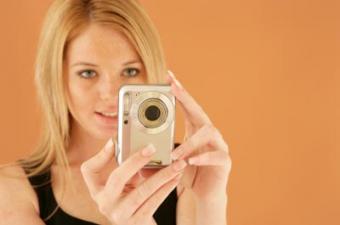
If you're still using a film camera to take pictures for your scrapbook, you may find yourself wondering about the rationale for digital photography.
About Digital Photography
Digital photography uses computer technology to create, print, store, transmit, and manipulate images without the need for chemical processing. Instead of film, most digital cameras use built in and/or removable solid state flash memory.
Contrary to popular belief, you don't necessarily need access to your own computer to enjoy the benefits of digital photography. Stores such as Wal-Mart and Target have kiosks that let you order prints from your camera's memory card and a CD containing backup copies of your images. If you wish, you can even purchase a dye-sublimation printer to make your own fade proof and water resistant prints at home.
Understanding the Rationale for Digital Photography
Instant gratification, affordability, and easy image editing are the three advantages most frequent cited by those making the switch from a film camera to digital photography.
Instant Gratification
For scrapbookers eager to play with the last paper and embellishments, the greatest rationale for digital photography is instant gratification. You can take photos at your nephew's birthday party in the afternoon and make a layout of the event later that night. If you wish, you can even create an entire vacation album while the trip is still fresh in your mind!
Affordability
With digital photography, there's no need to buy film on a regular basis. Once you've purchased a memory card for your camera, you can take an unlimited number of photos and simply download them to your computer or order prints as necessary. The cost-effectiveness of digital photography encourages experimentation, because there's no need to worry about "wasting" film in your quest for the perfect shot.
Easy Image Editing
Image editing software such as Adobe Photoshop Elements makes it easy to edit your digital photos. You can remove red eye, crop out distracting background elements, or apply special effects filters to turn your photos into unique artwork. When you're finished, you can even upload your photos to your own Web site to easily share with family and friends.
Buying Your First Digital Camera
Before purchasing your first digital camera, it's important to take the time to assess your needs as a photographer. For example:
- What type of photos do you commonly take? Do you enjoy taking simple snapshots or do you have a serious interest in sports photography? Do you frequently take photos at night?
- Do you plan to print your photos at home? If so, do you have a computer and printer that can handle this task?
- How large of prints do you want? While a simple 4 megapixel camera will produce sufficient 4x6 prints, those who plan to order larger sizes on a regular basis will want to invest in a higher quality camera.
While many people choose their digital camera equipment by asking a more experienced friend for advice, it's important to remember that an experienced photographer is able to take good pictures with almost any camera. In fact, many experienced photographers are so adept at working around the limitations of their camera that they forget what issues are likely to be of concern for the novice. Your goal should be to find a camera that it will make it easy for you to take good photos in the widest variety of situations. Take the time to research cameras online and play with the models at your local electronics store before making your final purchase.
Additional Information
To learn more about the rationale for digital photography, check out the following helpful Web sites:
You may also be interested in these digital photography reference books:
- Digital Photography: Top 100 Simplified Tips & Tricks by Gregory Georges
- Digital Photography for Dummies by Julie Adair King
- Digital Photography Pocket Guide by Derrick Story
- The Betterphoto Guide to Digital Photography by Jim Miotke







